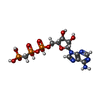[English] 日本語
 Yorodumi
Yorodumi- PDB-4j95: Crystal Structure of FGF Receptor 2 (FGFR2) Kinase Domain Harbori... -
+ Open data
Open data
- Basic information
Basic information
| Entry | Database: PDB / ID: 4j95 | ||||||
|---|---|---|---|---|---|---|---|
| Title | Crystal Structure of FGF Receptor 2 (FGFR2) Kinase Domain Harboring the Pathogenic K659N Mutation Responsible for an Unclassified Craniosynostosis Syndrome in Space Group C2. | ||||||
 Components Components | Fibroblast growth factor receptor 2 | ||||||
 Keywords Keywords |  TRANSFERASE / Kinase Domain Fold Consisting of N- and C-lobes / TRANSFERASE / Kinase Domain Fold Consisting of N- and C-lobes /  Receptor Tyrosine Kinase / Receptor Tyrosine Kinase /  ATP Binding ATP Binding | ||||||
| Function / homology |  Function and homology information Function and homology informationSignaling by FGFR2 amplification mutants / Signaling by FGFR2 fusions / fibroblast growth factor receptor signaling pathway involved in negative regulation of apoptotic process in bone marrow cell / fibroblast growth factor receptor signaling pathway involved in hemopoiesis / fibroblast growth factor receptor signaling pathway involved in positive regulation of cell proliferation in bone marrow / fibroblast growth factor receptor signaling pathway involved in mammary gland specification / lateral sprouting from an epithelium / mammary gland bud formation / branch elongation involved in salivary gland morphogenesis / mesenchymal cell differentiation involved in lung development ...Signaling by FGFR2 amplification mutants / Signaling by FGFR2 fusions / fibroblast growth factor receptor signaling pathway involved in negative regulation of apoptotic process in bone marrow cell / fibroblast growth factor receptor signaling pathway involved in hemopoiesis / fibroblast growth factor receptor signaling pathway involved in positive regulation of cell proliferation in bone marrow / fibroblast growth factor receptor signaling pathway involved in mammary gland specification / lateral sprouting from an epithelium / mammary gland bud formation / branch elongation involved in salivary gland morphogenesis / mesenchymal cell differentiation involved in lung development / lacrimal gland development / otic vesicle formation / prostate gland morphogenesis / regulation of smooth muscle cell differentiation / orbitofrontal cortex development / regulation of morphogenesis of a branching structure / squamous basal epithelial stem cell differentiation involved in prostate gland acinus development / branching morphogenesis of a nerve / embryonic organ morphogenesis / endochondral bone growth / morphogenesis of embryonic epithelium / epidermis morphogenesis / bud elongation involved in lung branching / positive regulation of epithelial cell proliferation involved in lung morphogenesis / pyramidal neuron development / membranous septum morphogenesis / reproductive structure development / limb bud formation / lung lobe morphogenesis / gland morphogenesis / fibroblast growth factor receptor signaling pathway involved in orbitofrontal cortex development / ventricular zone neuroblast division / embryonic digestive tract morphogenesis / epithelial cell proliferation involved in salivary gland morphogenesis / mesenchymal cell differentiation / branching involved in prostate gland morphogenesis / mesenchymal cell proliferation involved in lung development / branching involved in labyrinthine layer morphogenesis / FGFR2b ligand binding and activation / FGFR2c ligand binding and activation / Activated point mutants of FGFR2 / regulation of osteoblast proliferation / Phospholipase C-mediated cascade; FGFR2 /  fibroblast growth factor receptor activity / branching involved in salivary gland morphogenesis / embryonic pattern specification / outflow tract septum morphogenesis / positive regulation of phospholipase activity / lung-associated mesenchyme development / mesodermal cell differentiation / digestive tract development / regulation of smoothened signaling pathway / embryonic cranial skeleton morphogenesis / bone morphogenesis / fibroblast growth factor receptor activity / branching involved in salivary gland morphogenesis / embryonic pattern specification / outflow tract septum morphogenesis / positive regulation of phospholipase activity / lung-associated mesenchyme development / mesodermal cell differentiation / digestive tract development / regulation of smoothened signaling pathway / embryonic cranial skeleton morphogenesis / bone morphogenesis /  skeletal system morphogenesis / skeletal system morphogenesis /  odontogenesis / ureteric bud development / positive regulation of mesenchymal cell proliferation / regulation of osteoblast differentiation / ventricular cardiac muscle tissue morphogenesis / inner ear morphogenesis / Signaling by FGFR2 IIIa TM / organ growth / midbrain development / hair follicle morphogenesis / lung alveolus development / odontogenesis / ureteric bud development / positive regulation of mesenchymal cell proliferation / regulation of osteoblast differentiation / ventricular cardiac muscle tissue morphogenesis / inner ear morphogenesis / Signaling by FGFR2 IIIa TM / organ growth / midbrain development / hair follicle morphogenesis / lung alveolus development /  fibroblast growth factor binding / prostate epithelial cord arborization involved in prostate glandular acinus morphogenesis / PI-3K cascade:FGFR2 / fibroblast growth factor binding / prostate epithelial cord arborization involved in prostate glandular acinus morphogenesis / PI-3K cascade:FGFR2 /  bone mineralization / prostate epithelial cord elongation / positive regulation of cell division / bone mineralization / prostate epithelial cord elongation / positive regulation of cell division /  excitatory synapse / positive regulation of Wnt signaling pathway / PI3K Cascade / excitatory synapse / positive regulation of Wnt signaling pathway / PI3K Cascade /  epithelial to mesenchymal transition / negative regulation of keratinocyte proliferation / fibroblast growth factor receptor signaling pathway / embryonic organ development / epithelial to mesenchymal transition / negative regulation of keratinocyte proliferation / fibroblast growth factor receptor signaling pathway / embryonic organ development /  cell fate commitment / positive regulation of cell cycle / SHC-mediated cascade:FGFR2 / cellular response to retinoic acid / FRS-mediated FGFR2 signaling / positive regulation of cardiac muscle cell proliferation / positive regulation of vascular associated smooth muscle cell proliferation / cellular response to transforming growth factor beta stimulus / Signaling by FGFR2 in disease / epithelial cell differentiation / cell fate commitment / positive regulation of cell cycle / SHC-mediated cascade:FGFR2 / cellular response to retinoic acid / FRS-mediated FGFR2 signaling / positive regulation of cardiac muscle cell proliferation / positive regulation of vascular associated smooth muscle cell proliferation / cellular response to transforming growth factor beta stimulus / Signaling by FGFR2 in disease / epithelial cell differentiation /  axonogenesis / post-embryonic development / regulation of ERK1 and ERK2 cascade / positive regulation of epithelial cell proliferation / Negative regulation of FGFR2 signaling / animal organ morphogenesis / lung development / axonogenesis / post-embryonic development / regulation of ERK1 and ERK2 cascade / positive regulation of epithelial cell proliferation / Negative regulation of FGFR2 signaling / animal organ morphogenesis / lung development /  bone development / bone development /  receptor protein-tyrosine kinase / peptidyl-tyrosine phosphorylation / positive regulation of canonical Wnt signaling pathway receptor protein-tyrosine kinase / peptidyl-tyrosine phosphorylation / positive regulation of canonical Wnt signaling pathwaySimilarity search - Function | ||||||
| Biological species |   Homo sapiens (human) Homo sapiens (human) | ||||||
| Method |  X-RAY DIFFRACTION / X-RAY DIFFRACTION /  SYNCHROTRON / SYNCHROTRON /  MOLECULAR REPLACEMENT / Resolution: 2.3767 Å MOLECULAR REPLACEMENT / Resolution: 2.3767 Å | ||||||
 Authors Authors | Chen, H. / Mohammadi, M. | ||||||
 Citation Citation |  Journal: Cell Rep / Year: 2013 Journal: Cell Rep / Year: 2013Title: Cracking the Molecular Origin of Intrinsic Tyrosine Kinase Activity through Analysis of Pathogenic Gain-of-Function Mutations. Authors: Chen, H. / Huang, Z. / Dutta, K. / Blais, S. / Neubert, T.A. / Li, X. / Cowburn, D. / Traaseth, N.J. / Mohammadi, M. | ||||||
| History |
|
- Structure visualization
Structure visualization
| Structure viewer | Molecule:  Molmil Molmil Jmol/JSmol Jmol/JSmol |
|---|
- Downloads & links
Downloads & links
- Download
Download
| PDBx/mmCIF format |  4j95.cif.gz 4j95.cif.gz | 458.1 KB | Display |  PDBx/mmCIF format PDBx/mmCIF format |
|---|---|---|---|---|
| PDB format |  pdb4j95.ent.gz pdb4j95.ent.gz | 377.2 KB | Display |  PDB format PDB format |
| PDBx/mmJSON format |  4j95.json.gz 4j95.json.gz | Tree view |  PDBx/mmJSON format PDBx/mmJSON format | |
| Others |  Other downloads Other downloads |
-Validation report
| Arichive directory |  https://data.pdbj.org/pub/pdb/validation_reports/j9/4j95 https://data.pdbj.org/pub/pdb/validation_reports/j9/4j95 ftp://data.pdbj.org/pub/pdb/validation_reports/j9/4j95 ftp://data.pdbj.org/pub/pdb/validation_reports/j9/4j95 | HTTPS FTP |
|---|
-Related structure data
| Related structure data |  4j96C  4j97C  4j98C  4j99C  2pvyS S: Starting model for refinement C: citing same article ( |
|---|---|
| Similar structure data |
- Links
Links
- Assembly
Assembly
| Deposited unit | 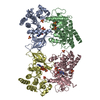
| ||||||||
|---|---|---|---|---|---|---|---|---|---|
| 1 | 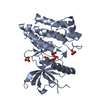
| ||||||||
| 2 | 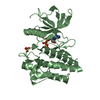
| ||||||||
| 3 | 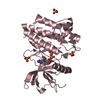
| ||||||||
| 4 | 
| ||||||||
| 5 | 
| ||||||||
| 6 | 
| ||||||||
| Unit cell |
| ||||||||
| Components on special symmetry positions |
|
- Components
Components
| #1: Protein |  / FGFR-2 / K-sam / KGFR / Keratinocyte growth factor receptor / FGFR-2 / K-sam / KGFR / Keratinocyte growth factor receptorMass: 37095.504 Da / Num. of mol.: 4 Fragment: Human FGF Receptor 2 Kinase Domain (UNP Residues 458-768) Mutation: C491A, K659N Source method: isolated from a genetically manipulated source Source: (gene. exp.)   Homo sapiens (human) / Gene: BEK, FGFR2, KGFR, KSAM / Production host: Homo sapiens (human) / Gene: BEK, FGFR2, KGFR, KSAM / Production host:   Escherichia coli (E. coli) / Strain (production host): BL21(DE3)pLys-S Escherichia coli (E. coli) / Strain (production host): BL21(DE3)pLys-SReferences: UniProt: P21802,  receptor protein-tyrosine kinase receptor protein-tyrosine kinase#2: Chemical | ChemComp-ACP / #3: Chemical | ChemComp-SO4 /  Sulfate Sulfate#4: Water | ChemComp-HOH / |  Water Water |
|---|
-Experimental details
-Experiment
| Experiment | Method:  X-RAY DIFFRACTION / Number of used crystals: 1 X-RAY DIFFRACTION / Number of used crystals: 1 |
|---|
- Sample preparation
Sample preparation
| Crystal | Density Matthews: 2.61 Å3/Da / Density % sol: 52.91 % |
|---|---|
Crystal grow | Temperature: 298 K / Method: vapor diffusion, hanging drop / pH: 7.5 Details: 100mM HEPES pH7.5, 25% PEG 4000, 200mM (NH4)2SO4, 3% v/v CH3CH2OH, VAPOR DIFFUSION, HANGING DROP, temperature 298K |
-Data collection
| Diffraction | Mean temperature: 100 K / Ambient temp details: SINGLE WAVELENGTH |
|---|---|
| Diffraction source | Source:  SYNCHROTRON / Site: SYNCHROTRON / Site:  NSLS NSLS  / Beamline: X4A / Wavelength: 0.979 Å / Beamline: X4A / Wavelength: 0.979 Å |
| Detector | Type: ADSC QUANTUM 4r / Detector: CCD / Date: Sep 16, 2011 |
| Radiation | Monochromator: KOHZU DOUBLE CRYSTAL / Protocol: SINGLE WAVELENGTH / Monochromatic (M) / Laue (L): M / Scattering type: x-ray |
| Radiation wavelength | Wavelength : 0.979 Å / Relative weight: 1 : 0.979 Å / Relative weight: 1 |
| Reflection | Resolution: 2.376→50 Å / Num. all: 95475 / Num. obs: 60839 / % possible obs: 99.4 % / Redundancy: 7.5 % / Rsym value: 0.059 / Net I/σ(I): 50.8 |
| Reflection shell | Resolution: 2.376→2.44 Å / Redundancy: 7.6 % / Mean I/σ(I) obs: 7.8 / Rsym value: 0.417 / % possible all: 99.3 |
- Processing
Processing
| Software |
| |||||||||||||||||||||||||||||||||||||||||||||||||||||||||||||||||||||||||||||||||||||||||||||||||||||||||
|---|---|---|---|---|---|---|---|---|---|---|---|---|---|---|---|---|---|---|---|---|---|---|---|---|---|---|---|---|---|---|---|---|---|---|---|---|---|---|---|---|---|---|---|---|---|---|---|---|---|---|---|---|---|---|---|---|---|---|---|---|---|---|---|---|---|---|---|---|---|---|---|---|---|---|---|---|---|---|---|---|---|---|---|---|---|---|---|---|---|---|---|---|---|---|---|---|---|---|---|---|---|---|---|---|---|---|
| Refinement | Method to determine structure : :  MOLECULAR REPLACEMENT MOLECULAR REPLACEMENTStarting model: PDB ENTRY 2PVY Resolution: 2.3767→37.55 Å / SU ML: 0.28 / σ(F): 1.34 / Phase error: 27.64 / Stereochemistry target values: ML
| |||||||||||||||||||||||||||||||||||||||||||||||||||||||||||||||||||||||||||||||||||||||||||||||||||||||||
| Solvent computation | Shrinkage radii: 0.9 Å / VDW probe radii: 1.11 Å / Solvent model: FLAT BULK SOLVENT MODEL | |||||||||||||||||||||||||||||||||||||||||||||||||||||||||||||||||||||||||||||||||||||||||||||||||||||||||
| Refinement step | Cycle: LAST / Resolution: 2.3767→37.55 Å
| |||||||||||||||||||||||||||||||||||||||||||||||||||||||||||||||||||||||||||||||||||||||||||||||||||||||||
| Refine LS restraints |
| |||||||||||||||||||||||||||||||||||||||||||||||||||||||||||||||||||||||||||||||||||||||||||||||||||||||||
| LS refinement shell |
| |||||||||||||||||||||||||||||||||||||||||||||||||||||||||||||||||||||||||||||||||||||||||||||||||||||||||
| Refinement TLS params. | Method: refined / Origin x: 32.4383 Å / Origin y: 20.3732 Å / Origin z: 14.0409 Å
| |||||||||||||||||||||||||||||||||||||||||||||||||||||||||||||||||||||||||||||||||||||||||||||||||||||||||
| Refinement TLS group | Selection details: all |
 Movie
Movie Controller
Controller




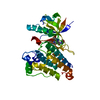


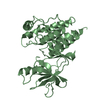


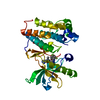

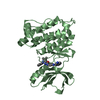
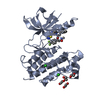
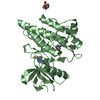
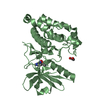
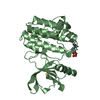
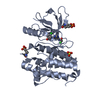
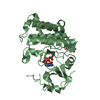

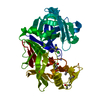

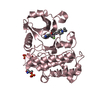
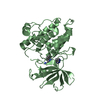
 PDBj
PDBj







